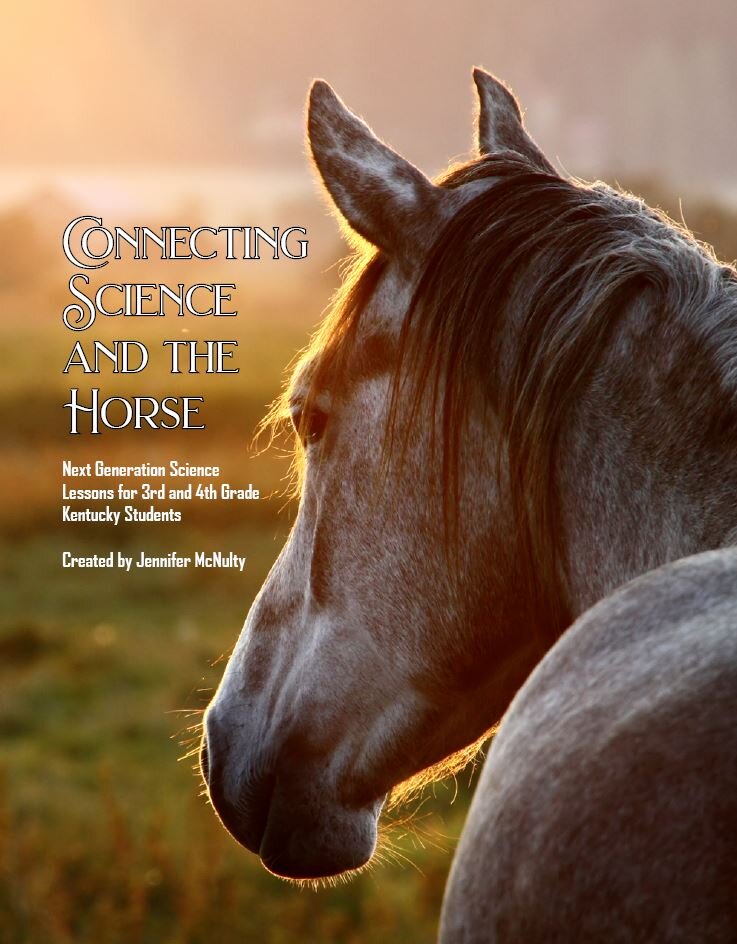Regional Teacher Workshops to Focus on the Horse!
We are proud to announce that we will be offering a new Kentucky Academic Standards-aligned curriculum with a horses and science theme this summer at the IN-PERSON Kentucky Farm Bureau Regional Teacher Workshops:
Thursday, June 3 – Murray State University Equine Center, Murray
Tuesday, June 8 – Western Kentucky University L.D. Brown Ag Expo Center, Bowling Green
Thursday, June 10 – Overlook Events Center, Pikeville
Tuesday, June 15 – Kentucky Horse Park, Lexington
Thursday, June 17 – Kentucky Derby Museum, Louisville
The curriculum, that meets several third and fourth grade NGSS science standards (see below the registration button), was written by Kentucky teacher and horse enthusiast Jennifer McNulty. Her set of lessons and hands-on training are being made available to teachers thanks to a partnership with the Kentucky Agriculture and Environment in the Classroom, the Kentucky Department of Agriculture, the Kentucky Agricultural Development Fund, Kentucky Farm Bureau, and the Kentucky Horse Council.
Kentucky is well known for its horse industry. The limestone rich soils, abundant water and forages, and temperate climate are a perfect place to raise the majestic animal that has been vitally important to our economy. Our horse farms are valued at $23 billion and support more than 40,000 jobs.
While it is only a small part of Kentucky’s agricultural enterprise, horses are an easy way to teach concepts of life sciences, ecosystems, and animal husbandry, and these concepts easily translate to other animals for comparisons.
Next Generation Science Standards Covered with this Curriculum Package
It’s In the Water - Ecosystems (Grade 3), Inherited Traits & Biological Evolution (Grade 3), and Earth Science (Grade 4)
3-LS4-3. Construct an argument with evidence that in a particular habitat some organisms can survive well, some survive less well, and cannot survive at all.
3-LS3-2. Use evidence to support the explanation that traits can be influenced by the environment.
4-ESS1-1. Identify evidence from patterns in rock formations and fossils in rock layers to support an explanation for changes in a landscape over time.
4-ESS1-2. Make observations and/or measurements to provide evidence of the effects of weathering or the rate of erosion by water, ice, wind, or vegetation.
4-ESS2-2. Analyze and interpret data from maps to describe patterns of Earth’s features.
Horse Vision - Light Waves, Structures & Processes (Grade 4)
4-LS1-1. Construct an argument that plants and animals have internal and external structures that function and support survival, growth, behavior, and reproduction.
4-LS1-2. Use a model to describe that animals receive different types of information through their senses, process the information in their brain, and respond to the information in different ways.
4-PS4–2. Develop a model to describe that light reflecting from objects and entering the eye allows objects to be seen.
Feeding Racehorses and Fourth Graders - Biological Evolution (Grade 3), Inherited Traits (Grade 3) and Structures & Processes (Grade 4)
3-LS4-3. Construct an argument with evidence that in a particular habitat some organisms can survive well, some survive less well, and cannot survive at all.
3-LS3-2. Use evidence to support the explanation that traits can be influenced by the environment.
3-LS4-2. Use evidence to construct an explanation for how variations in characteristics among individuals of the same species may provide advantages in surviving, finding mates, and reproducing.
3-LS4-4. Make a claim about the merit of a solution to a problem caused when the environment changes and the types of plants and animals that live there may change.
4-LS1-1. Construct an argument that plants and animals have internal and external structures that function to support survival, growth, behavior, and reproduction.
4-LS1-2. Use a model to describe that animals receive different types of information through their senses, process the information in their brain, and respond to the information in different ways.
Coat Color and Camouflage - Biological Evolution (Grade 3), Inherited Traits (Grade 3) and Structures & Processes (Grade 4)
3-LS3-1. Analyze and interpret data to provide evidence that plants and animals have traits inherited from parents and that variation of these traits exists in a group of similar organisms.
3-LS3-2. Use evidence to support the explanation that traits can be influenced by the environment.
3-LS4-2. Use evidence to construct an explanation for how the variations in characteristics among individuals of the same species may provide advantages in surviving, finding mates, and reproducing.
3-LS4-3. Construct and argument with evidence that in a particular habitat some organisms can survive well, some survive less well, and cannot survive at all.
4-LS1-1. Construct an argument that plants, and animals have internal and external structures that function and support survival, growth, behavior, and reproduction.
4-LS1-2. Use a model to describe that animals receive different types of information through their senses, process the information in their brain, and respond to the information in different ways.
Basic Needs: Shelter and Space Building a House for a Horse - Biological Evolution (Grade 3), Earth & Human Activity (Grade 3), Structure & Processes (Grade 4), and Engineering and Design (Grades 3-5)
3-LS4-3. Construct an argument with evidence that in a particular habitat some organisms can survive well, some survive less well, and cannot survive at all.
3-ESS3-1. Make a claim about the merit of a design solution that reduces the impacts of a weather-related hazard.
4-LS1-1. Construct and argument that plants and animals have internal and external structures that function to support survival, growth, behavior, and reproduction.
4-LS1-2. Use a model to describe that animals receive different types of information through their senses, process the information in their brain, and respond to the information in different ways.
3-5.ETS1-1. Define a simple design problem reflecting a need or want that includes specified criteria for success and constraints on materials, time, or cost.
3-5.ETS1-2. Generate and compare multiple possible solutions to a problem based on how well each is likely to meet the criteria and constraints of the problem.
Career Studies
There will also be an appendix that includes profiles from horse industry professionals so students can investigate different career possibilities.




